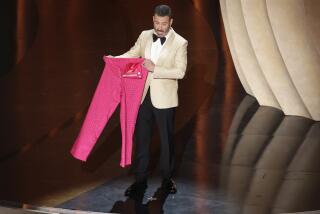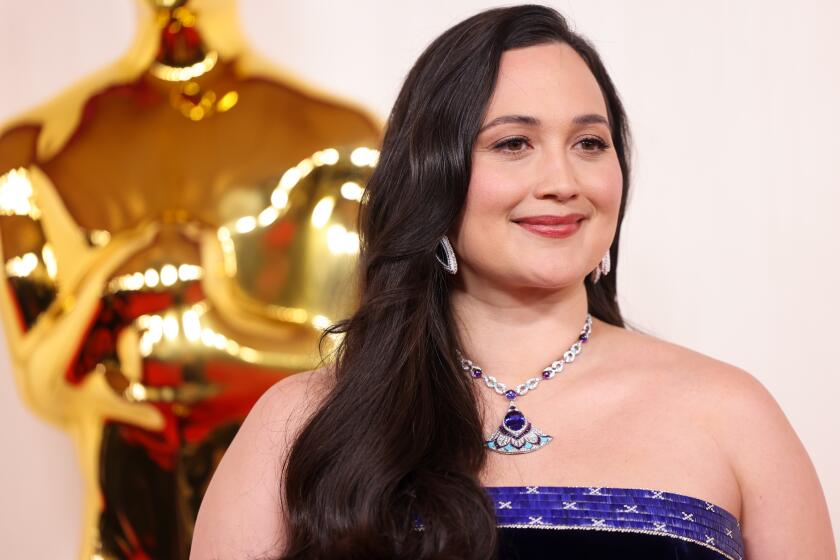CRITICS’ PICKS HINT AT OSCAR RACES
With two full weeks left on the 1986 calendar, three of the four major critics’ organizations have settled on the best cinematic achievements of the year. Despite their rush to judgment and the fact that many critics did not see all of the movies that will be released by Dec. 31, some patterns developed that likely will be followed all the way through to the Oscar nominations in February.
Woody Allen’s “Hannah and Her Sisters,” released by Orion Pictures 10 months ago, emerged as their big favorite. “Hannah” and Allen finished either first or second in the best picture and best director balloting by the National Board of Review and by the critics groups in both New York and Los Angeles.
“Hannah’s” Dianne Wiest scored a clean sweep, winning or tying in the best supporting actress category of all three groups’ ballots. English actor Daniel Day Lewis was named best supporting actor by the National Board and the New York critics for both “My Beautiful Laundrette” and “Room With a View.”
The only other multiple winner was Bob Hoskins (“Mona Lisa”), who topped the best actor lists of the critics in New York and here. Paul Newman (“The Color of Money”) was named best actor by the National Board of Review, an organization made up of film historians, scholars and academicians.
The three groups disagreed on best actress. New York selected Sissy Spacek (“Crimes of the Heart”); the Board of Review voted for Kathleen Turner (“Peggy Sue Got Married”), and the growingly eccentric Los Angeles club named Sandrine Bonnaire for the French film “Vagabond.”
The Los Angeles critics, who last year forced Universal Pictures to release “Brazil” by voting it three major awards, apparently came very close to voting those same awards this year to David Lynch’s highly controversial “Blue Velvet.”
Lynch was named best director over Allen in Los Angeles and “Blue Velvet” was second to “Hannah” for best picture. Lynch was also runner-up to Allen in the screenplay category. Meanwhile, Dennis Hopper was named best supporting actor for his work in both “Blue Velvet” and “Hoosiers.”
“Blue Velvet” also was a strong contender in several categories in New York. One of the members there said that the film was third in the final balloting for both picture and director and that it finished second to “Room With a View” in cinematography.
While most of the winners of the critics’ awards can probably count on having Oscar nominations to go with them, there is not likely to be much support among academy members for “Blue Velvet,” a film laced with mayhem and sexual violence. Critics tend to appreciate movies that take chances, especially in this lingering era of Hollywood conservatism, but academy voters have more conventional tastes.
Critics in both Los Angeles and New York (it’s almost impossible to locate members of the secretive National Board of Review) generally agree that while 1986 was not loaded with top quality movies, there were signs of positive change.
“There were not a lot of great movies, but it was a good year for quirky, smaller films,” said David Ansen of Newsweek. “I am cautiously optimistic. Certain trends seem to have been reversed this year. The tide of teen-age movies is receding. . . . There were quite a few films, like ‘Blue Velvet’ and ‘Sid and Nancy,’ that certainly took some chances.”
What was missing this year were the usual “big” movies, the “Color Purples” and “Out of Africas” that may potentially score with all three key groups--critics, audiences and academy voters. The two movies that best fill that mold--ambitious pictures with big casts, big budgets and strong studio support--were “The Mission” and “The Mosquito Coast.” Neither film was a factor with the critics.
“ ‘The Mission’ didn’t have the critical acclaim at all,” said Kirk Honeycutt of the Daily News in Los Angeles. “It did get the cinematography award (from the L.A. critics). Anybody who has an entire jungle to shoot should come away with something.”
Some critics, The Times’ Sheila Benson and Kevin Thomas among them, felt there was a bounty of good films in 1986. Gene Siskel, the tall half of the “Siskel & Ebert & the Movies” syndicated movie review show, said that his list of potential Top 10 movies had 19 titles on it--the most in his 18 years of reviewing.
“Some risky movies were made and did cause a stir,” Siskel said, adding that he was almost as pleased with the debate caused by “Blue Velvet” as he was by the movie itself. “Being challenged by films is what the moviegoing experience ought to be.”
There are a couple of films yet to be released this month that may have been hurt by the early polling of the critics. Oliver Stone’s “Platoon” and Frank Oz’s “Little Shop of Horrors,” both of which have enjoyed great advance word-of-mouth, went unseen by most members of the National Board of Review and by a significant number of critics in both New York and Los Angeles.
“Platoon,” based on Stone’s combat experience in Vietnam, finished second to “Hannah” in New York’s best picture voting, and Stone was runner-up to Allen as best director. The film reportedly had support among members of the Los Angeles group, but according to a spokesperson for Orion, which is releasing the film, as many as a half-dozen of the 30 members did not see it.
The last major critics group to vote will be the National Society of Film Critics. They convene Jan. 2, after all the eligible films have been released. Good for them.
GOLDEN TURKEY: After its thudding preview screenings in Westwood last week, some Hollywood wags were ready to rename Eddie Murphy’s “The Golden Child” “Eddie the Duck,” unkindly comparing it to the George Lucas bomb that landed last summer.
But despite the local reaction, echoed by most critics around the country, “The Golden Child” got off to an $11.5-million opening weekend, nearly double the receipts for Orion’s “Three Amigos,” which finished the weekend in second place.
The two new movies pushed “Star Trek IV: The Voyage Home” from first to third place in the box-office standings. “Star Trek” did $5 million over its third weekend and after 19 days, has grossed $46.6 million.
“Crimes of the Heart,” the other new release, got into the Top 10 with $1.4 million in only 246 theaters.
“Golden Child,” even with its big opening, does not figure to match the huge grosses of Murphy’s last Christmas hit, “Beverly Hills Cop.” As Daily Variety’s James Greenberg points out, “Beverly Hills Cop” did almost $4 million more business than “Golden Child” on the same weekend two years ago, in 145 fewer theaters.
“Beverly Hills Cop” also had better word-of-mouth from people in that opening weekend rush. According to Cinemascore, a private exit-poll service, “Golden Child” was given an overall rating of B by viewers last weekend. Cinemascore’s Ed Mintz said that a rating of B, which is equivalent to “average,” usually indicates a quick fall-off at the box office.
“Three Amigos” also received an overall B rating from Cinemascore respondents, but it got an A- from people who said they couldn’t wait to see it, compared to the B+ given “The Golden Child” by its most eager viewers.
Orion got better news from Cinemascore on “Hoosiers,” which was opened for one Academy Award-qualifying week in one Los Angeles theater. “Hoosiers” got an overall rating of A and an A+ from those who couldn’t wait to see it.
The Top 10 grossing movies last weekend: “The Golden Child”; “Three Amigos”; “Star Trek IV”; “Heartbreak Ridge” ($4.7 million); “An American Tail” ($2.6 million); “ ‘Crocodile’ Dundee” ($2.3 million); “Crimes of the Heart”; “Song of the South” ($1 million); “Peggy Sue Got Married” ($820,000); “The Color of Money” ($694,000).
More to Read
Only good movies
Get the Indie Focus newsletter, Mark Olsen's weekly guide to the world of cinema.
You may occasionally receive promotional content from the Los Angeles Times.










